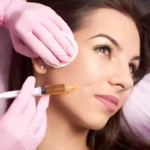

Juvéderm Voluma XC, also recognized as Voluma, distinguishes itself as a highly sought-after dermal filler in the comprehensive Juvederm product lineup. Developed by industry pioneer Allergan, this hyaluronic acid-based dermal filler received prompt approval from the Food and Drug Administration (FDA). Positioned as a versatile solution, Juvéderm Voluma XC is FDA-approved for augmenting volume in the cheeks and midface. Beyond its sanctioned applications, it finds extensive use in off-label treatments, effectively addressing areas such as the nose, temples, and chin. Explore the benefits of buying Juvéderm for your aesthetic practice today.
Its mild side effects include swelling and its effects last for up to 2 years. Juvederm Voluma XC costs up to $1000 per syringe and treatment cost varies depending upon individual clients needs.
What is Juvéderm Voluma?
Juvéderm Voluma is a smooth gel that retains its shape over a long period of time. It is commonly used to correct symptoms of aging, such as volume loss in the cheeks and surrounding areas.
All of the Juvéderm fillers beginning with the letter V are created using Vycross technology. This method is highly concentrated and cross-linked, allowing for more points of attachment between molecules.
Hyaluronic acid (HA), the main active compound in Voluma, is a naturally occurring sugar that is found in the human body. It also contains lidocaine, an anesthetic that reduces pain and discomfort in the treated area.
Where Should Juvéderm Voluma be Used?
Voluma was developed for use in the midface and cheek areas and is currently only FDA-approved for this. That being said, there are a handful of off-label uses for the dermal filler that have had desirable results, such as around the nose, chin, temples and under the eyes.
Aesthetic Surgery Journal found Voluma nose injections to have a positive effect in 96% of people who used the product, while JAMA Facial Plastic Surgery looked at Voluma for use in the undereye area, with 71% of patients reporting great results. In a study done in Europe, Voluma injections into the chin found a 98% success rate in improving the aesthetic.
Although further study may prove positive, currently Juvéderm Voluma is not a suitable filler to use in the lips and the surrounding areas. Due to high viscosity, this may result in a lumpy appearance.
Treating these areas may not be FDA-approved due to a lack of published evidence supporting the effectiveness or due to the manufacturer not seeking approval.
How Does Juvéderm Voluma Work?
Juvéderm Voluma operates similarly to other dermal fillers. It is injected into the desired area and the areas surrounding it, penetrating deep into the skin. It is then massaged evenly into the treatment area. The result is a plumper face with more volume in the cheeks.
How Effective is Juvéderm Voluma?
In order to achieve FDA approval, a 2-year controlled clinic trial was performed. Random and multicentered, its goal was to prove the safety and effectiveness of Juvéderm Voluma XC.
The study found that nearly 50% of the group maintained their positive outcomes for 24 months, with most of the patients experiencing an objective improvement in volume and appearance.
Many subjects reported looking an average of 5 years younger, with full results being seen after only 6 months of treatment. 90% of subjects felt satisfied with the results after 6 to 12 months.
Two additional studies corroborated this outcome, with the first seeing a 95% satisfaction rate in patients after only 3 weeks. The second study ran for 2 years and found 91% of patients to be satisfied with the results of Voluma.
All of the studies conducted concluded that Voluma is effective with very few negative side effects.
Safety and Side Effects
All dermal fillers, Voluma included, are considered safe treatments. All studies have shown serious complications and side effects to be rare and not directly linked to the use of Voluma alone.
However, some side effects can occur with the use of Juvéderm, including pain, redness, itching, swelling, tenderness and bruising after treatment.
In 94% of cases, these issues resolved themselves in an average of 2 weeks, although some subjects experienced infections and longer lasting side effects.
A small number of these cases required additional treatment with antibiotics, hyaluronidase or anti-inflammatories. Side effects are also noted to have lasted longer in subjects who are over the age of 50, and who received larger volumes Voluma.
In all cases, the symptoms were resolved either naturally or with treatment.
Aftercare and Recovery
Following treatment, it is advised that you avoid physically taxing activities, such as sports and exercising, harshly washing your face for 24 to 48 hours and direct sunlight for 24 to 48 hours.
If you are taking any type of herbal supplement or medication, primarily those that thin the blood, you may be at risk of bleeding during Voluma treatment.
All Juvéderm products have a typically short recovery time. In almost all cases the swelling, redness, and tenderness go away within 15 days.
If you experience symptoms that last longer or are more painful than expected, please contact your doctor immediately.
How Much Does Juvéderm Voluma Cost?
The average price of Juvéderm Voluma is $800 to $1,000 per syringe. Most treatments require only one syringe, but some may require more. For example, injections to the midface on those who are over 50 years old are likely to need 2 syringes, as well as treatments to the nose ands chin.
Due to the difference in desired results, the Voluma filler price varies and can be as high as $1,500 or more per syringe. Additionally, you are required to pay facility and physician fees, which also vary depending on the treatment and desired results.
While the price varies, Juvéderm Voluma generally provides a cost-effective alternative to other, more invasive, solutions for improving these areas.
Why is Juvéderm Voluma so expensive?
The cost of Juvederm Voluma is contingent upon the amount used, reflecting its tailored approach to achieving optimal results for each individual. Recognized for its robust lifting properties, Voluma stands at the forefront of advanced dermal fillers, providing a rejuvenating enhancement that goes beyond mere superficial changes.
Its long-lasting effects further contribute to the overall value, ensuring a sustained and natural-looking outcome. The meticulous formulation of Voluma, combined with its innovative technology, results in a product that commands a premium in the market. This investment, however, translates into a cosmetic solution that not only addresses immediate concerns but also offers a lasting and gratifying transformation over time. In essence, the elevated cost of Juvederm Voluma mirrors the exceptional quality and enduring benefits it brings to those seeking a superior and long-term solution for facial volume and contouring.
Juvéderm Voluma is a safe and effective facial dermal filler offering long-lasting results of up to 2 years. While Voluma is only approved for the cheek area by the Food and Drug Administration (FDA), it has had great results in the nose, chin, and undereye areas as well.
Aesthetic products generally refer to a broad category of items designed to enhance or improve one's appearance, often focusing on skincare, beauty, and personal grooming. These products are typically used to maintain or enhance physical attractiveness and may include a wide range of items intended for both professional and personal use. Here are some common types of aesthetic products:
-
Skincare Products: Including cleansers, moisturizers, serums, and treatments designed to address various skin concerns such as acne, aging, hyperpigmentation, and sensitivity.
-
Cosmetics: Makeup products such as foundations, concealers, eyeliners, lipsticks, and eyeshadows used to enhance facial features and achieve desired looks.
-
Hair Care Products: Shampoos, conditioners, styling products, and treatments to maintain and improve the health and appearance of hair.
-
Fragrances: Perfumes and colognes used to enhance personal scent and attractiveness.
-
Dental Care Products: Toothpaste, mouthwash, whitening treatments, and dental floss aimed at maintaining oral hygiene and enhancing smile aesthetics.
-
Personal Grooming Tools: Including razors, electric shavers, trimmers, and grooming kits used for hair removal and personal hygiene.
-
Beauty Devices: Devices such as facial cleansing brushes, LED light therapy masks, and microcurrent devices designed for at-home skincare treatments.
-
Nutritional Supplements: Supplements aimed at promoting skin health, hair growth, and overall well-being, often containing vitamins, minerals, and antioxidants.




